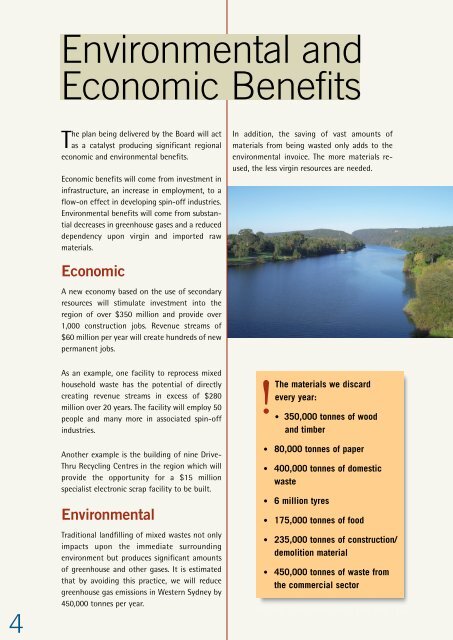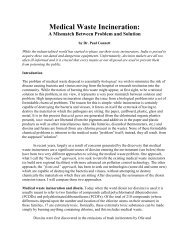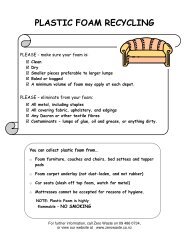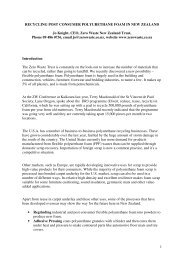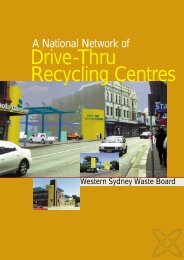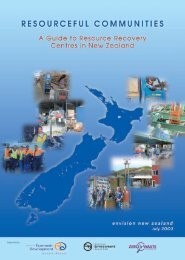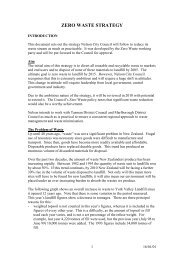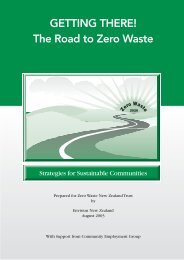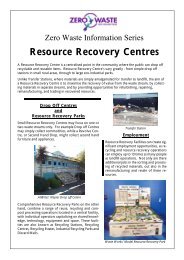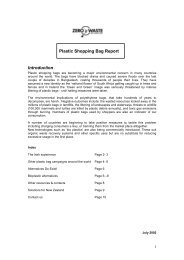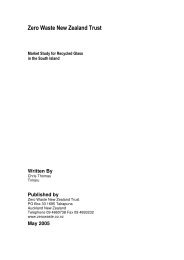From waste to wealth - Zero Waste
From waste to wealth - Zero Waste
From waste to wealth - Zero Waste
Create successful ePaper yourself
Turn your PDF publications into a flip-book with our unique Google optimized e-Paper software.
Environmental and<br />
Economic Benefits<br />
he plan being delivered by the Board will act<br />
Tas a catalyst producing significant regional<br />
economic and environmental benefits.<br />
Economic benefits will come from investment in<br />
infrastructure, an increase in employment, <strong>to</strong> a<br />
flow-on effect in developing spin-off industries.<br />
Environmental benefits will come from substantial<br />
decreases in greenhouse gases and a reduced<br />
dependency upon virgin and imported raw<br />
materials.<br />
Economic<br />
A new economy based on the use of secondary<br />
resources will stimulate investment in<strong>to</strong> the<br />
region of over $350 million and provide over<br />
1,000 construction jobs. Revenue streams of<br />
$60 million per year will create hundreds of new<br />
permanent jobs.<br />
As an example, one facility <strong>to</strong> reprocess mixed<br />
household <strong>waste</strong> has the potential of directly<br />
creating revenue streams in excess of $280<br />
million over 20 years. The facility will employ 50<br />
people and many more in associated spin-off<br />
industries.<br />
In addition, the saving of vast amounts of<br />
materials from being <strong>waste</strong>d only adds <strong>to</strong> the<br />
environmental invoice. The more materials reused,<br />
the less virgin resources are needed.<br />
!<br />
The materials we discard<br />
every year:<br />
• 350,000 <strong>to</strong>nnes of wood<br />
and timber<br />
4<br />
Another example is the building of nine Drive-<br />
Thru Recycling Centres in the region which will<br />
provide the opportunity for a $15 million<br />
specialist electronic scrap facility <strong>to</strong> be built.<br />
Environmental<br />
Traditional landfilling of mixed <strong>waste</strong>s not only<br />
impacts upon the immediate surrounding<br />
environment but produces significant amounts<br />
of greenhouse and other gases. It is estimated<br />
that by avoiding this practice, we will reduce<br />
greenhouse gas emissions in Western Sydney by<br />
450,000 <strong>to</strong>nnes per year.<br />
• 80,000 <strong>to</strong>nnes of paper<br />
• 400,000 <strong>to</strong>nnes of domestic<br />
<strong>waste</strong><br />
• 6 million tyres<br />
• 175,000 <strong>to</strong>nnes of food<br />
• 235,000 <strong>to</strong>nnes of construction/<br />
demolition material<br />
• 450,000 <strong>to</strong>nnes of <strong>waste</strong> from<br />
the commercial sec<strong>to</strong>r


